Dr. Sudhir Ravindran
info@altacit.com
Dr. Sudhir Ravindran is a Patent Attorney and CEO of Altacit Global – Strategic Consultants for Intellectual Property & Franchise. A graduate Mechanical Engineer from the University of Madras, India, Masters in Manufacturing Systems Engineering from the Warwick Manufacturing Group, UK and a Masters in Law from the School of Law, University of Warwick in International Economic Law. He can be reached at info@altacit.com.
Two statements quoted below can amplify the significant growth in the importance of intellectual property:
Commissioner of the United States Office of Patents in 1899.
“Everything that can be invented has been invented”
Thomas Watson, chairman of IBM in 1943.
“I think there is a world market for about five computers.”
All of which have become famous for obvious reasons! Indeed the world has developed far more in the past fifty years than in any other period of history. The reason is not political or economic but technological inventions, implementation and growth of new ideas and evolution of knowledge based industries resulting in creation of new forms of property.
The famous international author on property Bentham expresses the inter-relationship between law and property in his book Theory of Legislation as:
Property and law are born together, and die together.
Before laws were made there was no property; take
away laws, and property ceases.
At every stage of human development, property and property relations have determined to a great extent the structure of societies and the nature of governance within them. Legal systems evolved different concepts of property and fashioned rights and duties around them.
In India from time immemorial the right to property has been recognised and protected. Our ancestral lawgivers like Manu, Jimutavahana, Vignaneswara etc accepted the concept of private ownership. In the beginning the concept of property, which was limited to ownership and possession, now extends to any object of economic value. Distinct categories of property have been developed and recognised. Today the right to acquire, hold and dispose of property is a fundamental right guaranteed by the Indian Constitution; deprivation of property is prohibited except by process of law.
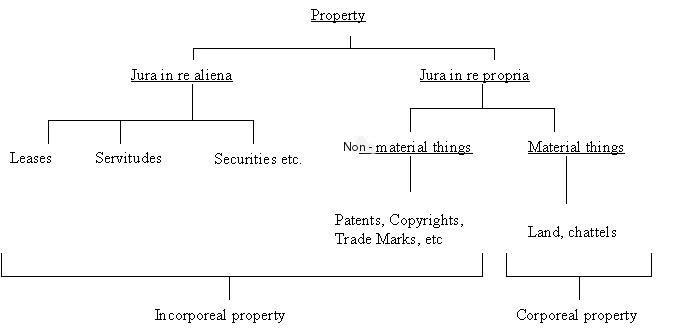
Every legal system develops rules that govern possession and holding of property. Rules for protecting property have to be framed considering the prevailing socio-economic-political background.
The development in science and technology has had its impact on the meaning of property giving a new dimension in development of rules for property protection. Evolving rules in socio-politico-economictechnological milieu saw the dawn and development of intellectual property.
Intellectual Property law protects some of the finer manifestations of human achievement. India faces several challenges as regards IPR and its role in innovation. Weak physical infrastructure, adequate intellectual capital but inadequate intellectual infrastructure, poor public awareness are but a few of the hurdles. The issues of generation, valuation, protection and exploitation of intellectual property have become critically important all around the world.
Intellectual property shares many of the characteristics associated with real and personal property. It is an asset that can be bought, sold, licensed, exchanged, or gratuitously given away. Further, the intellectual property owner has the right to prevent the unauthorized use or sale of the property. The most noticeable difference between intellectual property and other forms of property, however, is that intellectual property is intangible, that is, it cannot be defined or identified by its own physical parameters. It must be expressed in some discernible way to be protected.
In today’s dynamic and competitive business environment Intellectual Property (IP) rights are the key elements to maintain a competitive edge in the market. Effective acquisition, management, and protection of intellectual property can mean the difference between commercial success and failure for businesses.
The life of IP can be seen in the form of a cycle.
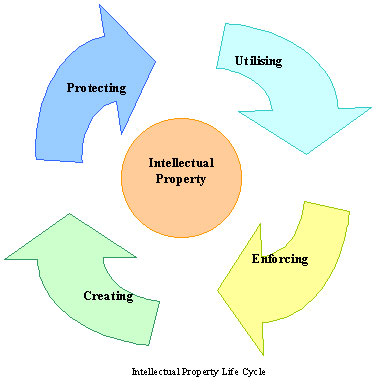
The four stages of the life cycle: (1) creating the intellectual property, (2) protecting the intellectual property, (3) utilising the intellectual property and (4) enforcing the intellectual property. The difference in regulation by countries complicates the legal issues at all stages, which supports the need to establish global standards in intellectual property laws.
Now lets look at each of the four stages of the IP life cycle to have a better understanding of IP and to compare it with Real Property.
Gone are the days of individual efforts like that of Watson, Bell, and Edison. Today, although individuals contribute to the creation of intellectual property, it is a collective endeavour that often involves huge R & D investment. In order to protect this investment, companies need to ensure that it owns any and all work created by its employees and independent contractors. Only then can the company reap profits by capitalizing on such intellectual property.
The modern IPR tool kit which encompasses Patent, Copyright, Trade & Service Marks, Design Registration, Geographical Indications, Layout Designs for integrated circuits, provisions for Anticompetitive practices in contractual licenses, protections of new plant varieties etc. provides for a range of distinct legal framework for protection of the fruits of human creativity.
There are many similarities in the law relating to the different IP tools in regard to the nature of the property the mode of its acquisition, the nature of rights conferred, the commercial exploitation of those rights, the enforcement of those rights and remedies available against the infringement of those rights. It should be appreciated that the law not only creates rights and obligations but also provides for varying degrees of protection and enforcement procedures.
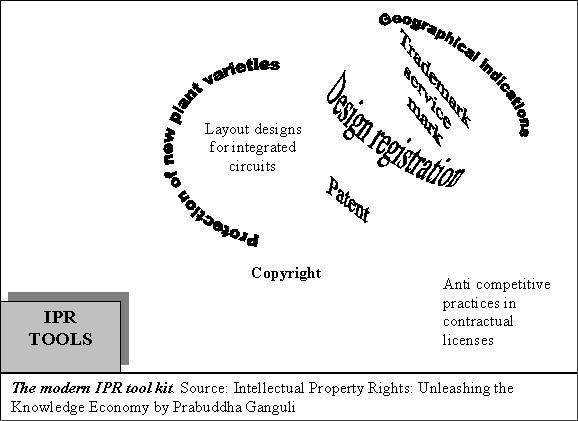
An appropriate combination of the instruments in the tool kit needs to be exploited to achieve optimal protection of a specific intellectual asset.
Let us look at this with an example of a simple ball point pen:

It would be interesting to note that a key word search in United States Patent and Trade Mark office website http://www.uspto.gov reveals that there are 1804 citations for technology related to ‘ballpoint pen’ that have been patented. ‘pen ink’ revealed 671 citations for various technologies that control the flow of ink. 120 citations for the keyword search ‘pen nib’. ‘pen body’ had 535 patents. ‘pen holder’ and ‘pen cap’ have 513 and 283 patents granted respectively. The technology of smooth writing has been granted 162 patents!
| Key word | No of Patents |
|---|---|
| Ball point pen | 1804 |
| Pen ink | 671 |
| Pen refill | 120 |
| Pen nib | 159 |
| Pen body | 535 |
| Pen clip | 95 |
| Pen holder | 513 |
| Pen cap | 283 |
| Smooth writing | 162 |
| Source: http://www.uspto.gov | |
This shows that various aspects of technology can be patented no matter how simple or small or tiny the invention.
The shape of a pen, the nib etc along with any unique aesthetic feature can be protected by a design registration. The literature accompanying the pen could attract copyright protection. The name of a pen can be a trademark.
Names and logos Sheaffer the world famous pen company uses to brand and market its products is illustrated here:

It is therefore important to understand the basic provisions and aspects of several of intellectual property laws, which foster innovations. Let us look at protection of each kind of IP now
Knowledge when transferred to technology creates intellectual property. Many corporate giants such as G.E., AT&T, Polaroid, Xerox and Hewlett-Packard, started as small companies and used patent protection to safeguard their inventions.
It is often said that a patent is society’s contract with the inventor. Patents protect inventions that are novel, non-obvious with respect to the prior art and useful. The invention must be disclosed in a specified format in a patent specification.
A patent once granted has a specific “term” and must be periodically renewed up to the end of the term to retain the exclusive rights derived from it such as the unauthorised production, use & sale of the invention. If not renewed periodically as required by the statute, a patent becomes public property that can be used by anyone without fear of infringement. Patent rights are geographical in nature; that is to say an invention, which is patented in India is not protected in another country unless individual protection is sought in that particular country.
An illustration of how paten systems have been used to protect inventions resulting in evolving products such as refrigerator, time clocks and vacuum cleaners is shown here. Thus, patent systems encourage the disclosure of information to the public by rewarding an inventor for his or her endeavours.
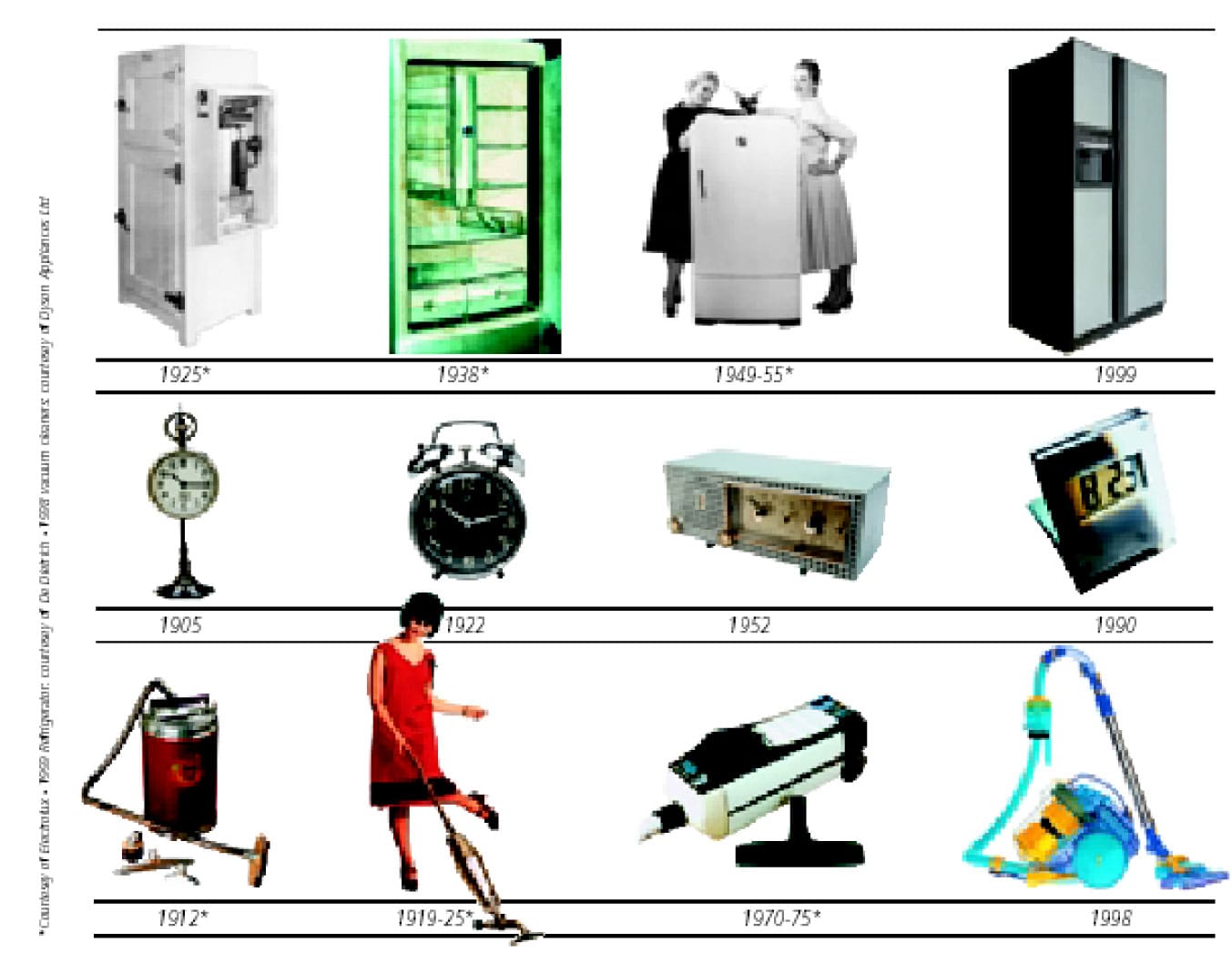
Inspiration for future. Source http://www.wipo.int
Justly, Patents offer at least four critical advantages to businesses:
The importance of biotechnology has made the relationship between intellectual property and biotechnological inventions relevant. Biotechnology inventions involve living entities. To satisfy the “sufficient disclosure” requirement of the patent law a practice has been developed for the biotechnological patents to deposit a sample of the microorganism with an authorised depository, which provides an ‘accession number’ which when quoted in the patent specification is considered as an equivalent description of the invention, therefore satisfying the sufficient disclosure of the invention. India is a member of the Budapest Treaty on recognition of the Deposit of microorganism for the purpose of patent procedure. The Indian Patents Act is silent on how to meet the sufficient description requirement in case of biological materials. Though there is no internationally recognised depository authority in India, the Patent Office in India recognises the accession number given by any such internationally recognised depository authority.
In India there are number of statutory bars to the patenting of certain biotechnological inventions and discoveries. Inventions relating to “a method of agriculture or horticulture”, “any process for medicinal, surgical, curative, prophylactic or other treatment of a human or plants to render them free of disease so as to increase their economic value or that of their products” are not patentable.
It is widely believed the German automobile manufacturer BMW purchased the British automobile manufacturer Rover primarily to obtain its portfolio of desirable trademarks including “Land Rover,” “Range Rover,” “Triumph,” “Austin,” and “MGB.” A trademark or service mark may be the most valuable asset of a company. On the other hand, a trademark may be virtually worthless if consumers associate it with poor quality.
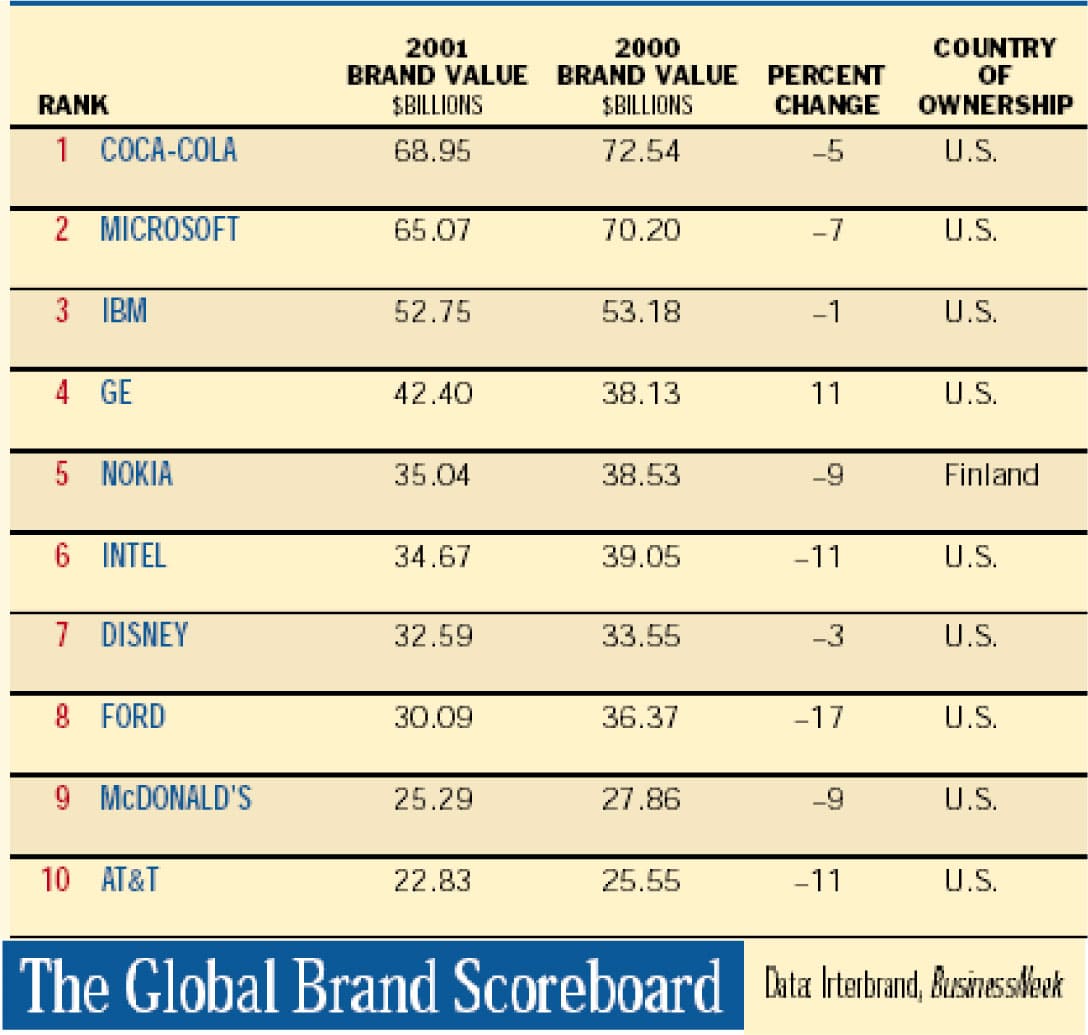
The value of the top ten brands globally is shown here. The sample data is an indication of the value of brand names globally. The mammoth valuation of these brands equals India’s external debt! All these brand names are protected under trademark law.
Trademarks and service marks are primarily intended to indicate the source and distinguish goods and services of others. They also symbolize the quality of the goods or services with which they are used. Most trademarks and service marks are words, but they can be almost anything such as symbols, logos, sounds, designs, or even distinctive non-functional product configurations. A trademark once granted is valid for a period of 7 years and can be perpetually renewed every 7 years.

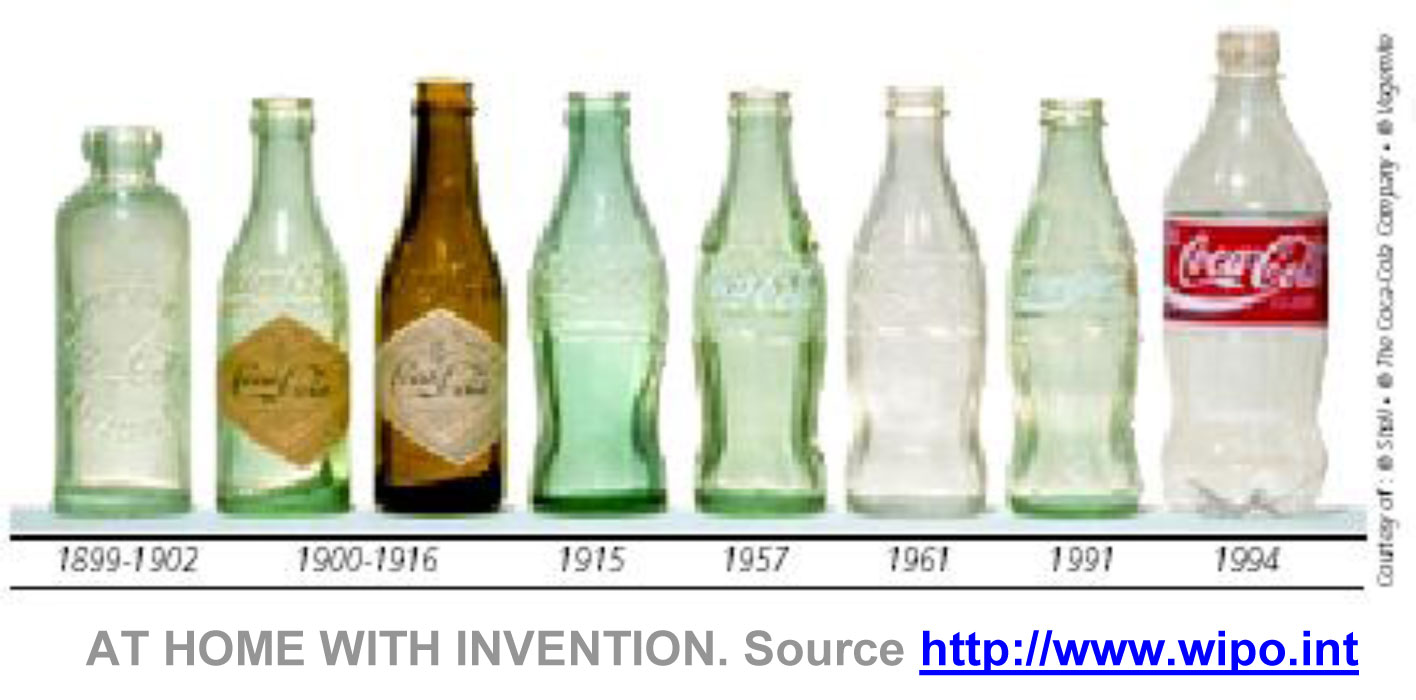
AT HOME WITH INVENTION. Source http://www.wipo.int
An illustration of the two most recognised and oldest brands on the face of the earth and how they have changed over the years is shown here.
The owner of a mark may preclude others from using a similar mark if such use is likely to cause confusion in the minds of purchasers. Determining whether two marks are so similar as to be confusing usually involves a multi-factor analysis that compares the parties marks, their goods or services, their advertising and trade channels, the defendant’s intent in choosing its mark, and the presence or absence of actual confusion. Some countries grant rights to a person for first use of the mark in the course of AT HOME WITH INVENTION. Source http://www.wipo.int business, while other countries grant rights to the person who first obtains a registration in that country. India follows the first to use system.
An industrial design, also known simply as a design, is the ornamental or aesthetic aspect of an article. The design may consist of three-dimensional features, such as the shape or surface of an article, or twodimensional features, such as patterns, lines, or colour. Industrial designs make an article attractive and appealing, and add to its commercial value. For this reason they are protected; an owner of a registered industrial design is assured an exclusive right against unauthorized copying or imitation of the design. Protection initially lasts for a period 10 years, after which it can usually be renewed for another 10 years.

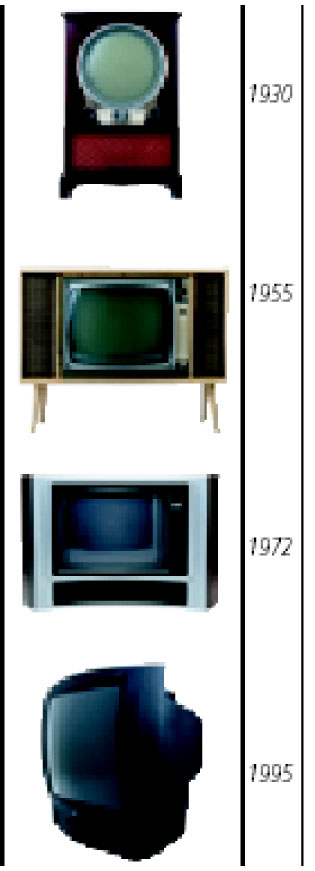
Source: World Intellectual Property Organisation
This protection helps economic development by encouraging creativity in industry, as well as in traditional arts and crafts. This can be seen in the illustrations: Over the years, improved designs have helped make telephones and televisions more efficient, attractive, and in tune with our needs.
The fundamental idea of violation of copyright or imitation is the abuse of the Eight Commandment: “Thou shalt not steal” which forms the moral basis of the protective provisions of the Copyright Act.

Copyrights are the rights given to creators for literary, musical, and artistic works, such as novels and poetry, songs and musical scores, paintings and sculpture etc. Other works protected by copyright include films, choreography, architecture, advertisements, maps, and technical drawings, as well as computer programs and databases.
The period for which the copyright subsists in India is 60 years from the end of the calendar year of the authorised publication or the lifetime of the author plus sixty years from the end of the calendar year in which the author dies. Where there are joint authors, the term of sixty years commences from the end of the calendar year in which the last of them dies. When the author is anonymous the sixty years shall be calculated from the year of the first publication.
The different rights conferred by the copyright Act are:
Internationally the Washington Treaty has substantive provisions for protection of Layout Designs for integrated circuits. The scope of protection not only includes the protected chip but also the articles incorporating it. The term of protection is 10 years.
A trade secret is information that is secret or not generally known in the relevant industry and that gives its owner an advantage over competitors. Trade secret protection exists as long as the information is kept secret or confidential by its owner and is not lawfully and independently obtained by others. Examples of trade secrets include formulas, patterns, methods, programs, techniques, processes, or compilations of information that provide one s business with a competitive advantage.
Trade secrets are not registered like other forms of intellectual property and are not creations of statutes. Instead, the judicial system of each country determines the requirements for obtaining trade secret protection. Protection for trade secrets is found in the Trade Related Intellectual Property Rights (TRIPs) Agreement under the heading “Protection of Undisclosed Information” (TRIPs Article 39).
The classic example given to illustrate the principle of trade secret is the recipe for Coca-Cola®, which is rumoured to be placed under lock and key, with no one having access. If the recipe or process for making the beverage had been patented, its owner would have enjoyed exclusive rights for only a limited time, after which the recipe or process would enter the public domain, In contrast, maintaining the recipe and process as trade secrets results in protection in perpetuity, as long as reasonable efforts are made to safeguard the confidentiality of the information. Trade secret law merely protects against the misappropriation of information. Thus, if a party independently develops or reverse engineers a patented item, infringement has occurred. In contrast, independent development does not and reverse engineering might not constitute a violation of another’s trade secret.
In the current fast changing global economy, Geographical Indications (GI) are emerging as an important intellectual property tool. Some well-known GIs are “Darjeeling Tea” from India, “Chianti Wine” from Italy, “Champagne Wine” from France; “Tequila Spirit” from Mexico; “Idaho Potatoes” from USA; “Swiss Chocolates” from Switzerland. All these names typically convey an assurance of quality & distinctiveness, which is essentially attributed to the fact of its origin from that defined geographical locality, region or territory.
A trade secret is information that is secret or not generally known in the relevant industry and that gives its owner an advantage over competitors. Trade secret protection exists as long as the information is kept secret or confidential by its owner and is not lawfully and independently obtained by others. Examples of trade secrets include formulas, patterns, methods, programs, techniques, processes, or compilations of information that provide one s business with a competitive advantage.
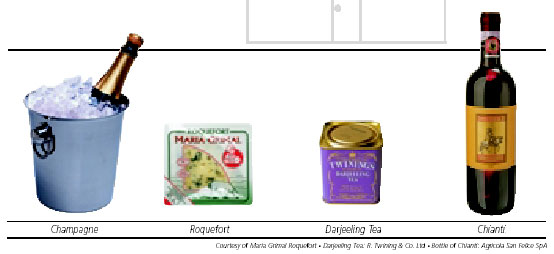
GEOGRAPHICAL INDICATIONS OF SOURCE http://www.wipo.int
Geographical Indications are similar to trademarks in that they function as source indicators. Geographical Indications prevent misuse of designation or presentation of a product, which indicates that the product originates in a place different from where it actually originates. However, the key distinction lies in the fact that while a trademark identifies a good or service as originating from a particular producer, a geographical indication identifies not the producer of the goods concerned, but the geographical region from where the product originates.
For example using “Darjeeling” for tea, which was not grown in the tea gardens of Darjeeling, is detrimental to consumers and legitimate producers. For wines and spirits such geographical indicators will be prevented even if true origin of the product is indicated. An example is the word ‘Champagne’ that is claimed exclusively by the Champagne region of France, which is the geographical region from which the wine derives its world famous name. No other wine, even if it is made from the same grape variety, by the same method, and is identical in taste, aroma and other qualities, can be called ‘Champagne’. Example the usage of the phrase “Champagne made in USA” is prohibited although it is not deceptive.
India has made a significant move in compliance with its commitment under the TRIPS by enacting the Geographical Indications of Goods (Registration & Protection) Act, 1999. The registration of a geographical indication is valid for a period of 10 years and can be renewed successively for further period of 10 years each. A registered geographical indication cannot be assigned, transmitted, mortgaged, pledged or licensed.
Countries like India that exclude patent protection to plant varieties are required to provide under the TRIPs protection to new plant varieties by an effective “sui generis” or any combination of “sui generis” and patents. The protection of new plant varieties is another aspect of intellectual property rights, and as such seeks to acknowledge the achievements of breeders of new plant varieties by giving them, for a limited period, an exclusive right. To obtain such protection, the new varieties must satisfy specific criteria.
The organisation overseeing the protection of new plant varieties is referred to as UPOV, which is an acronym derived from the French name for the organization, Union internationale pour la protection des obtentions végétales. India recently became a member of this organisation and has also put in place The Protection of Plant Varieties and Farmers Right Act 2001.
It is accepted that some licensing practices related to IPR, which restrain competition may have an adverse impact on trade and impede transfer of technology. Examples of such restrictive practices may include exclusive grant back conditions, conditions preventing challenges to validity and coercive packaging, licensing etc. Countries are encouraged to introduce legislations that discourage such restrictive practices in contractual licences but remain consistent within the provisions of TRIPs. This generally links to the national anti-trust/anti-competition laws and “compulsory licensing” that regulate “monopolistic practices”. These are country specific and are guided by international principles.
The third stage, utilising and strategically exploiting the company’s intellectual property, may involve licensing and cross-licensing arrangements, assignments, transfer of property etc. The owner of an intellectual property can assign any one or more of his numerous rights or any combination of those rights. It can be limited to areas or may be worldwide. It can also be limited to parts of a single right. Intellectual Property Rights can be assigned to more than one person. Intellectual Property may be assigned for a limited period or for the whole duration of term of the right. Considering the nature of IP it is advisable that the assignment be in writing, signed, and witnessed.
The terms of the assignment will have to be drafted carefully so that it represents correctly what is intended to be assigned and nothing is left vague. An agreement without consideration is not enforceable.
Licensing and assignment at times can lead to antitrust actions, which are potentially very severe. Although both intellectual property and antitrust handling may share the common purpose of promoting innovation and enhancing consumer welfare, their methods are opposite. Intellectual property law grants monopolies to encourage advance in science and art and is not dictated by price while antitrust policy generally prohibits monopolies in order to enhance economic efficiency. Thus, intellectual property needs special antitrust handling.
The fourth stage, enforcing the intellectual property, is the most important stage in the lifeline of an intellectual property. This stage prevents others from unauthorized utilisation and exploitation of protected intellectual property for the duration of the protection.
Intellectual property may be misappropriated in many ways. A copyrighted work may be infringed by making and selling an unauthorized copy, as with pirated computer software. A trademark may be infringed by selling a good with a counterfeit mark. A person can infringe a patent by manufacturing and selling a product that functions according to the patent’s description. A trade secret may be misappropriated by removing it from the possession of its. Enforcement may vary by national legislation.
Remedies for intellectual property infringement include injunctions, orders to deliver up or destroy infringing articles, and compensation for damages suffered by the IP owner or profits made by the infringer. Although civil remedies that provide compensation to wronged intellectual property rights holders are available, criminal sanctions are also available, if warranted to ensure sufficient punishment and deterrence of wrongful activity. Deterrence is crucial since violations of intellectual property rights often involve no loss of tangible assets and do not even require any direct contact with the rights holder, the rights holder often does not know it is a victim until a defendant’s activities are specifically identified and investigated.
Intellectual property-related laws cannot remain static in a world where economic development is becoming increasingly technology-based. Intellectual property laws are going to be more stringent and stricter in the days to come, offering more opportunities and challenges as was seen in the recent arrest and criminal prosecution of Russian national Dmitry Sklyarov in the U.S under the Digital Millennium Copyright Act. Dmitry did not infringe any intellectual property but provided a software tool that helped users infringe upon the e-book copy-protection system of Adobe Systems.
It can be perceived that Intellectual Property is more REAL than Real Property.


本网站没有旨在投放广告或教唆,而且网站内容不应被视为法律建议. 读者不应该认为这些信息是对客户关系的邀请.

© Altacit 全球公司的版权 2020. All Rights Reserved.